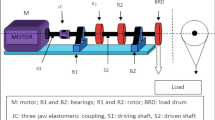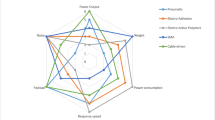Abstract
Nutation drive claims the advantages of high load capacity, large transmission ratio, desirable stability, low noise, and compact volume, which makes it an excellent alternative to typical joint reducers used in industrial robots. This paper proposes a novel two-stage nutation drive as a joint reducer for the industrial robot. The working principle of the nutation movement is first introduced followed by an analysis of transmission characteristics. The transmission ratio, the transmission efficiency as well as the structural schematic of the proposed nutation drive are presented. Finite element analysis of the main components, including nutation sleeve and bevel gears, was performed. Finally, a prototype was designed, manufactured and tested to verify the feasibility of applying the nutation drive as a joint reducer for industrial robots.
Similar content being viewed by others
References
W. D. He, L. X. Li and X. Li, New optimized tooth profile of cycloidal on high precision RV reducer for robot, Chinese Journal of Mechanical Engineering, 36(3) (2000) 51–55.
B. K. Chen and L. Tan, Contact priority element analysis and system development of cycloid planetary enveloping drive, Mechanical Strength, 35(3) (2013) 366–371.
F. S. Zhang, P. Zhu, C. Feng and L. L. Zhang, Study of transmission accuracy of RV reducer, Journal of Machine Design, 32(4) (2015) 1–4.
X. Wang, Q. J. Huang, B. Chen and Y. F. Hou, Theoretical analysis of the efficiency of RV reducer with beveloid gear, Journal of Mechanical Transmission, 39(10) (2015) 35–38.
B. Wei, J. X. Wang, G. W. Zhou, R. S. Yang, H. J. Zhou and T. He, Mixed lubrication analysis of modified cycloidal gear used in the RV reducer, Journal of Engineering Tribology, 230(2) (2016) 121–134.
Y. G. Sun, G. B. Yu, J. Zhang, F. Wang, Y. Q. Sun and J. H. Chen, Reliability prediction of RV reducer based on fault tree and monte-carlo simulation, Applied Mechanics and Materials, 274 (2013) 663–666.
Y. G. Sun, X. F. Zhao, F. Jiang, L. Zhao, D. Liu and G. B. Yu, Backlash analysis of RV reducer based on error factor sensitivity and monte-carlo simulation, International Journal of Hybrid Information Technology, 7(2) (2014) 283–291.
W. D. He, K. Y. Liu and X. H. Wu, Parameterization design of RV reducer, Journal of Dalian Jiaotong University, 36(1) (2015) 47–50.
W. D. He and Y. H. Zhang, Finite element modes analysis of involute planetary gear in RV reducer, Applied Mechanics and Materials, 44 (2010) 1018–1021.
X. A. Liu and H. H. Xu, Modeling and analysis of dynamic load characteristics of RV reducer, Mechanical Drive, 40(1) (2016) 106–109.
E. Y. Liu, C. Chen and F. C. Wang, Transmission accuracy analysis of harmonic reducer, Mechanical Engineer, 2 (2014) 3–5.
C. Zou, T. Tao, X. S. Mei, J. W. Lu and G. D. Jiang, Contact analysis for short harmonic reducer in robotic joints, Journal of Xi’an Jiaotong University, 47(5) (2013) 82–87.
F. Yan, W. Yang, C. C. Duan and J. X. Qiu, Fatigue life analysis of harmonic reducer flexspline, Modern Manufacturing Engineering, 10 (2013) 17–19.
Q. B. Tong, C. Q. Jiao, T. Ning and X. D. Zhang, Harmonic gear reducer transmission error analysis and detection, Advanced Materials Research, 711 (2013) 375–380.
J. L. Zhao, Y. X. Gu, S. Z. Yan and J. N. Wu, Dynamic analysis of flexible space manipulators with harmonic reducer, Key Engineering Materials, 584 (2013) 200–207.
S. Y. Chen and H. B. Xin, Speed torque measurement system design of micro harmonic drive, Applied Mechanics and Materials, 155 (2012) 455–458.
X. Wang and X. Zhou, Research on structure optimization design of flexible wheel of harmonic reducer, Manufacturing Automation, 10 (2013) 1–3.
X. C. Sha and Y. X. Fan, Research on transmission error of harmonic reducer, Machinery Manufacturing (2014) 50–54.
P. Fanghella, L. Bruzzone, S. Ellero and R. Lando, Kinematics, efficiency and dynamic balancing of a planetary gear train based on nutating bevel gears, Mechanics Based Design of Structures & Machines, 44(1–2) (2016) 72–85.
Y. W. Cai, L. G. Yao, Z. Y. Xie, J. Zhang and C. Peng, Influence analysis of system parameters on characteristics of the nutation drive with double circular arc spiral bevel gears, Forschung Im Ingenieurwesen, 81(2–3) (2017), 125–133.
G. X. Wang, J. Deng, P. Wang and L. J. Li, Meshing principle and dynamic simulation of nutation drive with face-gar, Journal of Dalian Jiaotong University, 38(2) (2017) 48–54.
K. Suzumori, T. Kanda, K. Uzuka and I. Enomoto, Nutation Motor: A New Direct-drive Stepping Motor for Robots, Institute of Electrical and Electronics Engineers Inc. (2004) 21–22.
K. Suzumori, T. Nagata, T. Kanda, K. Uzuka and I. Enomoto, Development of electromagnetic nutation motor (electromagnetic investigation), Journal of Robotics and Mechatronics, 16(3) (2004) 327–332.
K. Uzuka, I. Enomoto and K. Suzumori, Development of nutation motors (1st Report, Driving principle and basic characteristics of pneumatic nutation motor), Transactions of the Japan Society of Mechanical Engineers, 72(4) (2006) 1194–1199.
K. Uzuka, I. Enomoto and K. Suzumori, Development of nutation motors (2nd Report, Development of practical model by the of type bevel gears and diaphragm), Transactions of the Japan Society of Mechanical Engineers, 72(4) (2006) 1200–1206.
K. Uzuka, I. Enomoto, K. Suzumori and T. Kanda, Development of nutation motors (3rd Report, Development of electromagnetic nutation motor by the of type bevel gears and electromagnets), Transactions of the Japan Society of Mechanical Engineers, 73(4) (2007) 1188–1195.
K. Uzuka, I. Enomoto and K. Suzumori, Development of nutation motors (4th Report, Development of small-sized and high torque pneumatic nutation motor by the of type bevel gears and principle of lever), Transactions of the Japan Society of Mechanical Engineers, 73(6) (2007) 1731–1737.
K. Uzuka, I. Enomoto and K. Suzumori, Comparative assessment of several nutation motor types, IEEE/ASME Transactions on Mechatronics, 14(1) (2009) 82–92.
S. Oda, K. Suzumori, K. Uzuka and I. Enomoto, Development of nutation motors (Improvement of pneumatic nutation motor by optimizing diaphragm design), Journal of Mechanical Science and Technology (2010) 25–28.
A. M. Maroth and Uwe Riede, Nutation drive: A high-ratio power transmission, Mechanical Engineering, 95(2) (1997) 30–34.
J. H. Zhao and G. B. Zhang, Nutation gear train and calculation of its transmission ratio, Mechanical Science and Technology, 25(5) (1996) 21–23.
P. K. Gupta and H. V. White, On the kinematics of a nutating mechanical drive, Journal of Applied Mechanics, Transactions of the ASME, 42(2) (1975) 507–509.
Y. Kemper, The nutating traction drive, Journal of Engineering for Power, Transactions of the ASME, 103(1) (1981) 154–157.
Y. Kemper and L. Elfes, A continuously variable traction drive for heavy-duty agricultural and industrial applications, SAE Technical Paper Series (1981) 1–10.
S. J. He, Analysis on the elastohydrodynamic lubrication of involute nutation gear, Lubrication and Seal, 1 (1995) 28–31.
S. J. He, Theoretical research on cone rolling output mechanism of nutation gear, Coal Mine Machinery, 28(2) (2007) 55–57.
S. J. He, Strength study on zero tooth difference output mechanism of nutation gear drive, Machinery Design & Manufacture, 8 (2007) 23–24.
G. X. Wang and T. M. Guan, Modeling of nutation drive with rolling teeth, Applied Mechanics and Materials, 16 (2009) 708–712.
G. X. Wang, L. J. Li, H. Guan and T. M. Guan, Modeling and simulation for nutation drive with rolling teeth, Advanced Materials Research, 538 (2012) 470–473.
G. X. Wang, W. J. He and D. Li, Analysis of center disk tooth surface contact strength on nutation transmission with conical movable teeth, Journal of Dalian Jiaotong University, 2 (2016) 32–37.
B. Gu, L. G. Yao, G. W. Wei, Y. J. Cai and J. S. Dai, The analysis and modeling for nutation drives with double circular-arc helical bevel gears, Material Science Forum, 505 (2005) 949–954.
Y. J. Cai, L. G. Yao and B. Gu, Kinematical and dynamical simulations nutation drive with double circular-arc helical bevel gears, Drive System Technigue, 21(4) (2007) 22–26.
L. G. Yao, B. Gu, S. J. Huang, G. W. Wei and J. S. Dai, Mathematical modeling and simulation of the external and internal double circular-arc spiral bevel gears for the nutation drive, Journal of Mechanical Design, ASME, 132(2) (2010) 021008.1–10.
Z. Lin, L. G. Yao and Q. Lin, Contact trace of internal meshing double circular-arc spiral bevel gears, Advanced Materials Research, 945 (2014) 822–825.
J. Zhang, L. G. Yao, S. J. Huang and B. Gu, Tooth profile accurate modeling of internal and external double circular-arc spiral bevel, Modern Manufacturing Engineering, 1 (2015) 119–124.
J. L. Hong, L. G. Yao, W. T. Ji and Z. P. Huang, Kinematic modeling for the nutation drive based on screw theory, Procedia CIRP, 36 (2015) 123–128.
S. Z. Wu and D. Chen, Research progress on application of precision gear reducer in robot joint transmission, Journal of Henan Institute of Science & Technology, 42(6) (2014) 58–63.
Author information
Authors and Affiliations
Corresponding author
Additional information
Recommended by Associate Editor Hak Yi
Yongwu Cai received his B.S. degree in mechanical engineering and automation from Wuhan University of Science and Technology, China, in 2012. He is currently taking his Ph.D. at the School of Mechanical Engineering and Automation at Fuzhou University in Fuzhou, China. His research interests include robot mechanism and mechanical drive, modeling of complex surfaces and precise manufacturing.
Ligang Yao received his Ph.D. in mechanics from Harbin Institute of Technology, China, in 1996. He is currently a Professor at the School of Mechanical Engineering and Automation at Fuzhou University in Fuzhou, China. His research interests include robot mechanism and mechanical drive, rehabilitation robot, modern design method, and modeling of complex surfaces and precise manufacturing.
Jun Zhang received his Ph.D. in mechanical design and theory from Tianjin University, China, in 2007. He is currently a Professor at the School of Mechanical Engineering and Automation at Fuzhou University in Fuzhou, China. His research interests include robot mechanism and mechanical drive, mechanical system dynamics (dynamics of gear system, dynamics of machine tools, dynamics of ship structure, etc.).
Rights and permissions
About this article
Cite this article
Cai, Y., Yao, L., Zhang, J. et al. Feasibility analysis of using a two-stage nutation drive as joint reducer for industrial robots. J Mech Sci Technol 33, 1799–1807 (2019). https://doi.org/10.1007/s12206-019-0332-z
Received:
Revised:
Accepted:
Published:
Issue Date:
DOI: https://doi.org/10.1007/s12206-019-0332-z




